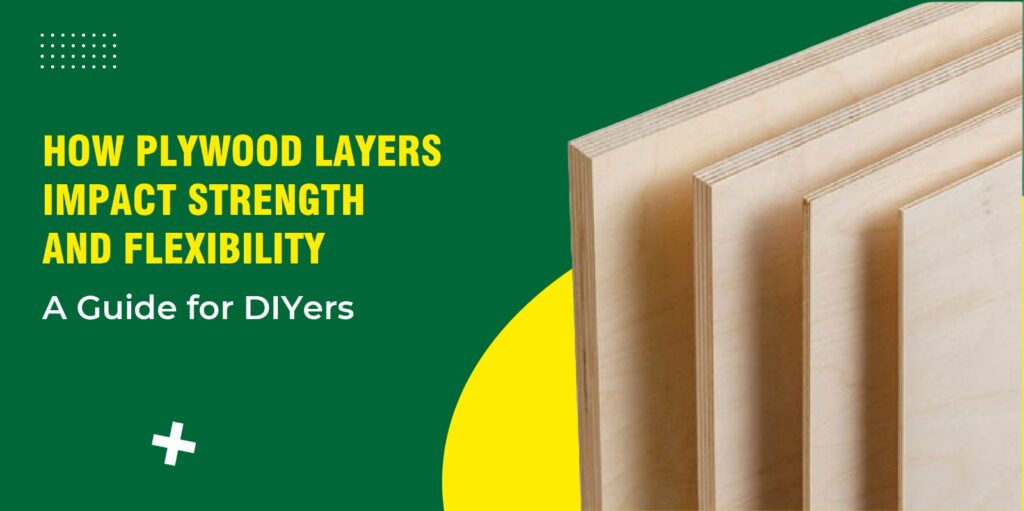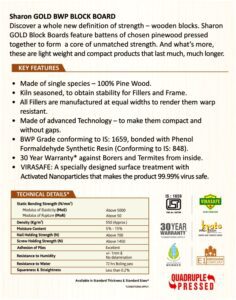

One of the most versatile and popular building materials in the world is plywood. Its unique structure, composed of multiple layers, gives it a distinct advantage over other types of wood products. Understanding how plywood layers influence its strength and flexibility is essential for making informed decisions in construction, furniture making and various DIY projects. In this blog, we will explore the composition of plywood, how its layers are configured and why this configuration is crucial for its performance. We will also touch on what makes the best plywood in India stand out in the market.
Wood veneer is cemented into thin layers, or “plies,” to create the manufactured wood panel known as plywood. Each layer in this stack is layered with its grain running perpendicular to the layer below it. The strength, stability and flexibility of the material are improved by this cross-graining method. The number of layers and the type of wood used can vary, resulting in different grades and types of plywood suited for various applications.
The outermost layers of plywood are known as the face and back veneers. These layers are typically made from higher-quality wood and are selected for their appearance and durability. The face veneer is the most visible part and often features a fine, smooth finish suitable for staining or painting.
The core of plywood consists of several layers of wood veneer sandwiched between the face and back veneers. These core layers can be made from a variety of wood types, including hardwoods and softwoods. The quality of the core layers significantly impacts the overall strength and stability of the plywood.
A key characteristic of plywood layers is cross-graining. By orienting each layer’s grain at right angles to the adjacent layers, plywood gains improved dimensional stability and resistance to warping. This method also distributes stress more evenly across the panel, enhancing its strength and flexibility.
The cross-laminated structure of plywood is the primary reason for its superior strength. Each layer’s grain direction alternates, reducing the risk of splitting along the grain and providing resistance against shearing forces. This makes plywood much stronger than solid wood of the same thickness.
The strength of plywood is also determined by its thickness and the number of layers. Generally, thicker plywood with more layers will be stronger and more rigid. For example, a 7-ply board is stronger and more stable than a 3-ply board of the same thickness.
The type and quality of adhesive used to bond the plywood layers also play a crucial role in its strength. High-quality adhesives ensure a strong bond between the layers, which is essential for maintaining the structural integrity of the plywood under stress.
The alternating grain direction in plywood layers not only contributes to strength but also to flexibility. This characteristic allows plywood to bend without breaking, making it ideal for applications where curvature is required, such as in boat building or custom furniture.
In general, thinner plywood is more pliable than thicker plywood. This is because thin plywood has fewer layers and is less rigid, allowing it to bend more easily. However, it’s important to balance flexibility with strength depending on the application.
Certain types of plywood, such as bendable or flexible plywood, are designed specifically for applications that require a high degree of flexibility. These plywood types typically have thinner core layers and are engineered to bend without cracking.
India is home to a variety of plywood manufacturers offering different grades and types of plywood. When selecting the best plywood in India, consider the following factors:
The best plywood is made from high-quality raw materials, including premium wood veneers and strong adhesives. Look for manufacturers who source their wood sustainably and use superior adhesives that enhance durability and strength.
To guarantee constant quality, reputable plywood producers in India follow tight manufacturing guidelines. Check for certifications such as the Indian Standards (IS) mark, which indicates compliance with national quality standards.
The best plywood manufacturers offer a wide range of products to suit different needs. Whether you need marine plywood for outdoor use or decorative plywood for interior applications, having options allows you to choose the best material for your project.
Consider the reputation of the manufacturer and reviews from other customers. Reliable brands with positive feedback are more likely to provide high-quality plywood that meets your expectations.
Plywood can be used for a variety of purposes due to its strength and flexibility.
In construction, plywood is used for structural purposes, such as flooring, roofing and wall sheathing. Its ability to withstand heavy loads and resist warping makes it an ideal choice for these applications.
Plywood is a popular material in furniture making due to its strength, stability and versatility. It can be used to create everything from cabinets and tables to intricate curved pieces.
In interior design, plywood is used for panelling, cabinetry and decorative elements. Its smooth surface and ability to hold finishes well make it a preferred choice for high-quality interior projects.
Marine plywood, made to withstand constant exposure to water, is used in boat building and other marine environments. Its durability and resistance to moisture are crucial for these demanding applications.
Use sharp tools and proper techniques when cutting and shaping plywood to avoid splintering and ensure clean edges. A fine-toothed saw blade or a carbide-tipped blade is ideal for this purpose.
When fastening plywood, use screws rather than nails to prevent splitting and ensure a strong hold. Pre-drilling holes can also help avoid damaging the layers.
Proper finishing enhances the appearance and durability of plywood. Sand the surface smoothly before applying paint, stain or varnish. Sealing the edges can also help protect against moisture.
Understanding the role of plywood layers in influencing strength and flexibility is essential for selecting the right type of plywood for your project. The cross-graining technique, quality of materials and the number of layers all contribute to the overall performance of plywood. When looking for the best plywood in India, consider factors such as raw material quality, manufacturing standards and the reputation of the manufacturer. With its versatility and robust properties, plywood continues to be a staple in construction, furniture making and design, offering endless possibilities for creative and durable projects.










Users understand that SHARONPLY is committed to protecting the User’s privacy and shall take all efforts to protect any personal data provided to the Website by reasonable security safeguards against such risks as loss or unauthorised use, destruction, modification or disclosure of data, However, in case of any lapse, SHARONPLY shall not be held responsible for any effect or consequences thereof. The Website uses cookies to track usage of the path of the User. Since most web browsers automatically accept cookies, User can edit User’s browser options to block them if User does not want the Website to use cookies to track usage of the path of the User.
SHARONPLY undertakes not to disclose, except as otherwise provided, the personal information provided by the User to any person, unless such action is necessary to: –
By filling up any form on the Website User automatically grants SHARONPLY a royalty-free, perpetual, irrevocable non-exclusive license to use, reproduce, publish, edit, distribute, and publicly display the information given in the form and to sublicense such rights.
Any queries regarding the SHARONPLY’s privacy policy, may be sent to admin@sharonply.com.

